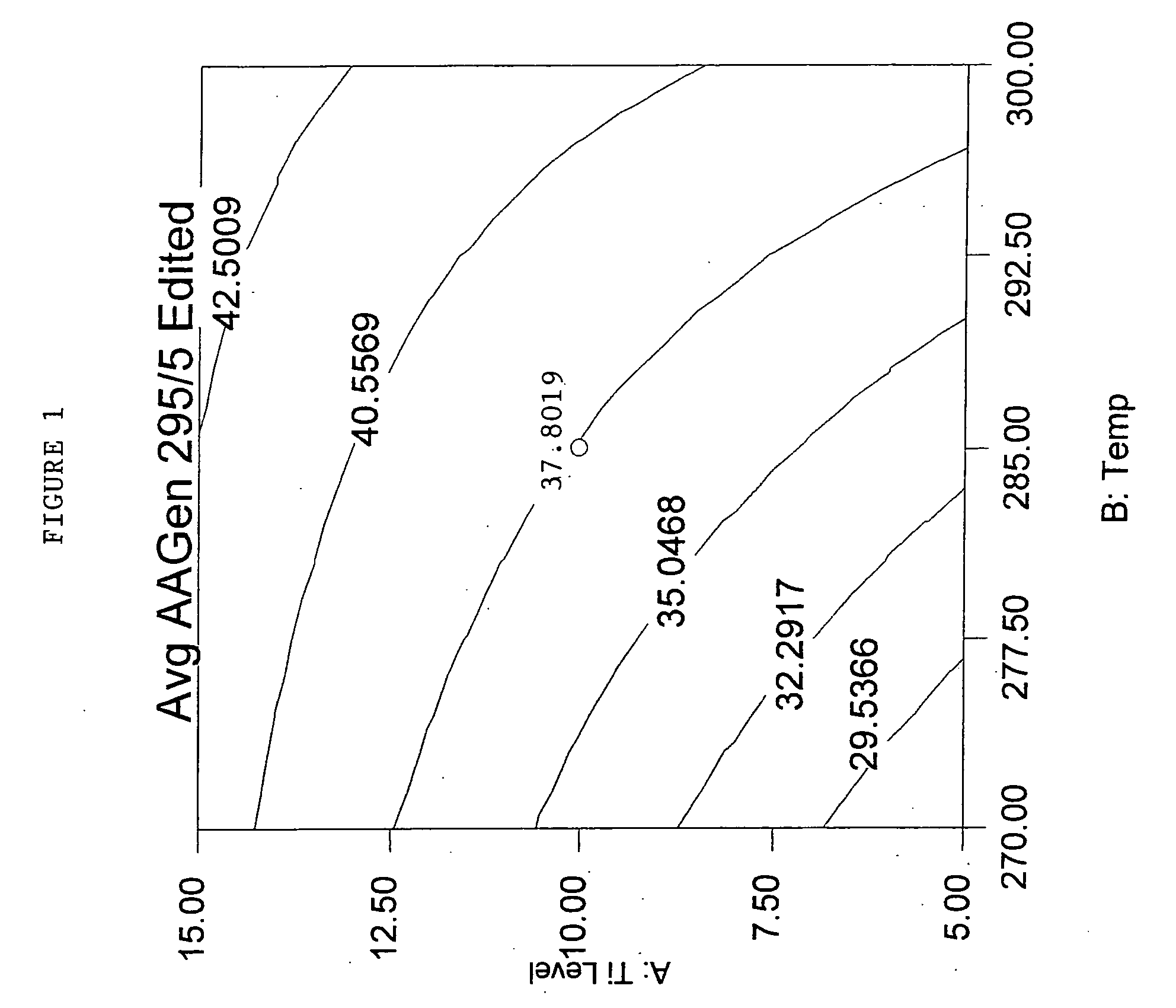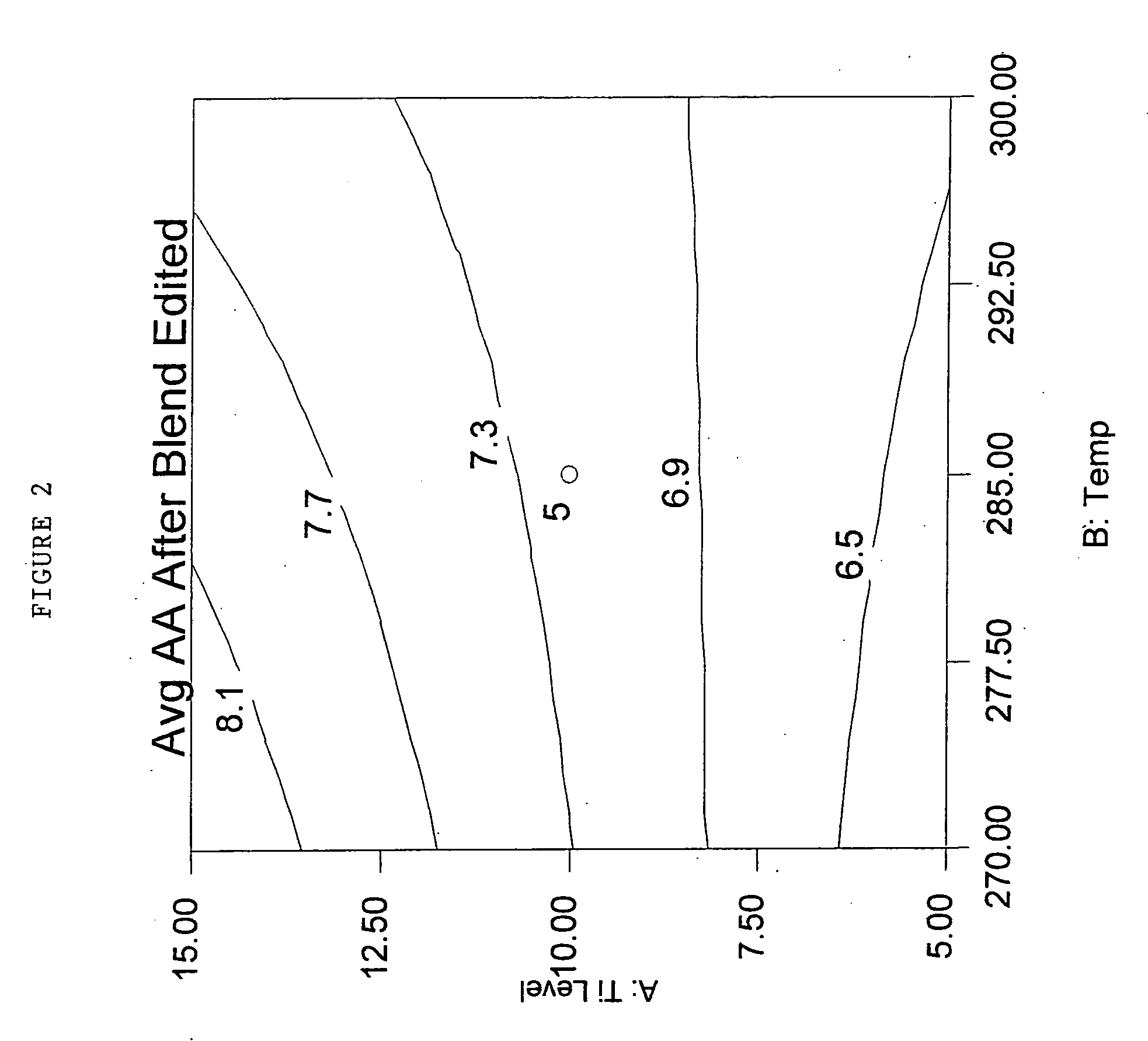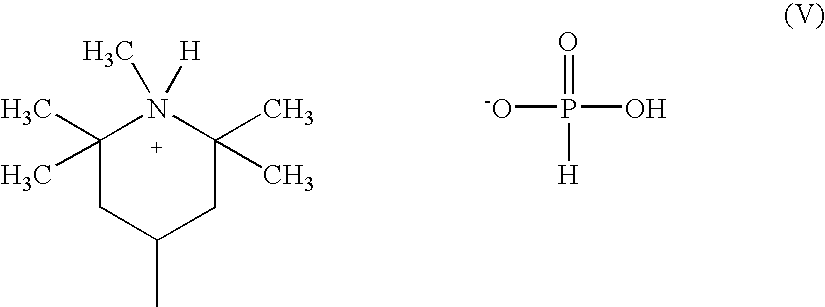Phosphorus containing compounds for reducing acetaldehyde in polyesters polymers
a technology of phosphorus and acetaldehyde, which is applied in the direction of organic compounds/hydrides/coordination complexes, physical/chemical process catalysts, tobacco, etc., can solve the problems of unacceptably high aa levels, adversely affecting taste, and giving unacceptable levels of aa in the preform, etc., to achieve low acetaldehyde content, high inherent viscosity, and the effect of reducing the conten
- Summary
- Abstract
- Description
- Claims
- Application Information
AI Technical Summary
Benefits of technology
Problems solved by technology
Method used
Image
Examples
examples
[0105] Free acetaldehyde content in the polymer following addition of the respective additives is assessed as follows. Following the end of the array or lab preparation, the polymer is cooled for about 15 min., separated from the glass flask, cooled for about 10 min. and then placed immediately into liquid nitrogen. The polymer is ground cryogenically to pass a 3 mm screen. The residual or free AA sample is kept frozen.
[0106] For preforms, it is sufficient to use ASTM # F2013-00 described below. Since the polymer is melted in an extruder prior to injection molding, there is an opportunity for any AA precursors to be converted to AA. When experimental PET samples are prepared in the laboratory, there is usually not enough material to mold performs to test AA. Experimental PET samples prepared in the laboratory are in the form of pellets or powders (most common). In the case of PET pellets or powders, there has been no melting after the manufacturing; therefore to give the samples a ...
example a
[0143] To make the phosphorous acid salts of CyasorbUV 3529, two moles of phosphorous acid were used per mole of CyasorbUV 3529, and reacted per the following procedure. The salts can be manufactured according to the description in per copending U.S. application Ser. No. 10 / 39,2575), which is fully incorporated herein by reference
[0144] To a 5-L, round-bottomed flask equipped with a mechanical stirrer, thermocouple, and a heating mantle is added 411.76 g of Cyasorb UV-3529 and 945 g of toluene. Cyasorb UV-3529 is a polymeric hindered amine light stabilizer believed to conform generally to the compounds of amine formula (12) set forth above R6=R7=R8=R9=R10=methyl; L1 is hexamethylene; and (R3)(R4)N— collectively represent a morpholino group. The slurry is heated to 60° C. and stirred until a homogeneous solution was obtained. Isopropyl alcohol (370 g) is added to the reaction vessel. A solution of 115.46 g (1.41 mol) of phosphorous acid dissolved into 370 g of isopropyl alcohol is a...
examples b
[0148] These examples use the melt-blending procedure outlined in Table 3 for the previous examples, and utilized 100 g of PET modified with about 2.6 mole % isophthalic acid and about 4.2 mole % diethylene glycol. This PET was produced on a production scale line with 10 ppm Ti and 0 ppm P. Examples prefaced with the letter “C” are comparative examples.
[0149] The % reduction in AA generation at 295° C. for 5 minutes (AA GEN 295 / 5) was calculated as follows: 1) an average AAGen for the runs with no additive was calculated to be 35.68 ppm, 2) the AAGen for a given run was divided by 35.68 ppm, 3) the quotient was multiplied by 100, and 4) the product was subtracted from 100. As can be seen from the Table 5, % reduction in AA GEN 295 / 5 was around 75% for around 55 ppm P from phosphorous acid salts of Cyasorb UV 3529 (“Cyasorb UV 3529-H3PO3”). The average AAGen of production control PET pellets tested at the same time was 23.5 ppm, much higher than the 8.5-9.3 ppm in the examples with ...
PUM
| Property | Measurement | Unit |
|---|---|---|
| temperatures | aaaaa | aaaaa |
| melt temperature | aaaaa | aaaaa |
| pressure | aaaaa | aaaaa |
Abstract
Description
Claims
Application Information
 Login to View More
Login to View More - R&D
- Intellectual Property
- Life Sciences
- Materials
- Tech Scout
- Unparalleled Data Quality
- Higher Quality Content
- 60% Fewer Hallucinations
Browse by: Latest US Patents, China's latest patents, Technical Efficacy Thesaurus, Application Domain, Technology Topic, Popular Technical Reports.
© 2025 PatSnap. All rights reserved.Legal|Privacy policy|Modern Slavery Act Transparency Statement|Sitemap|About US| Contact US: help@patsnap.com



